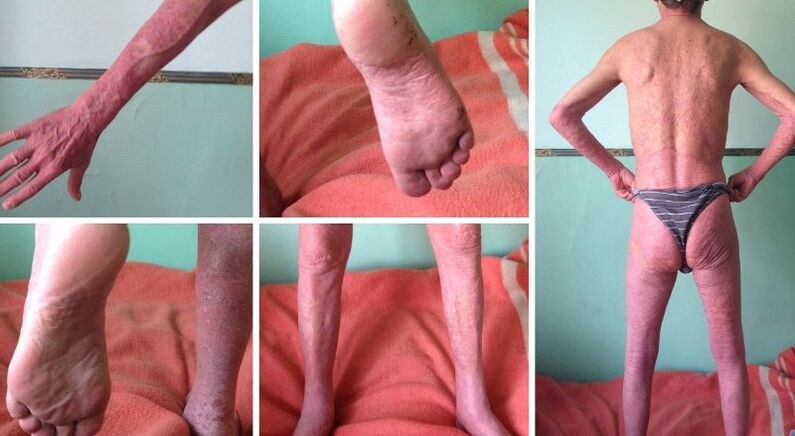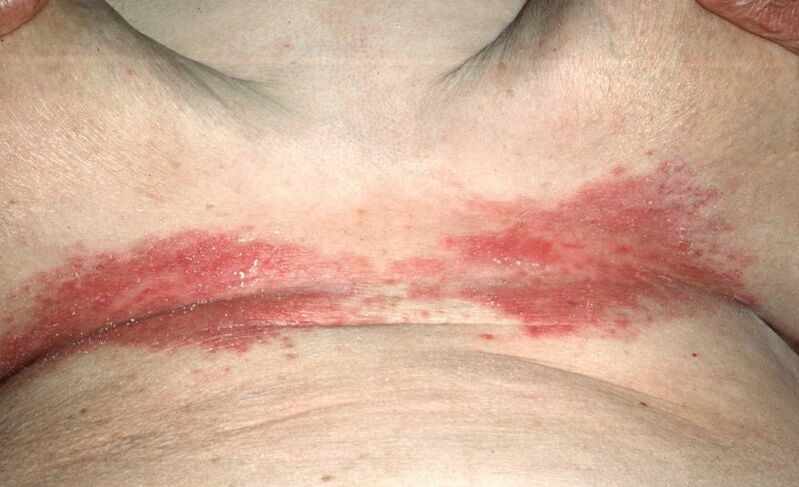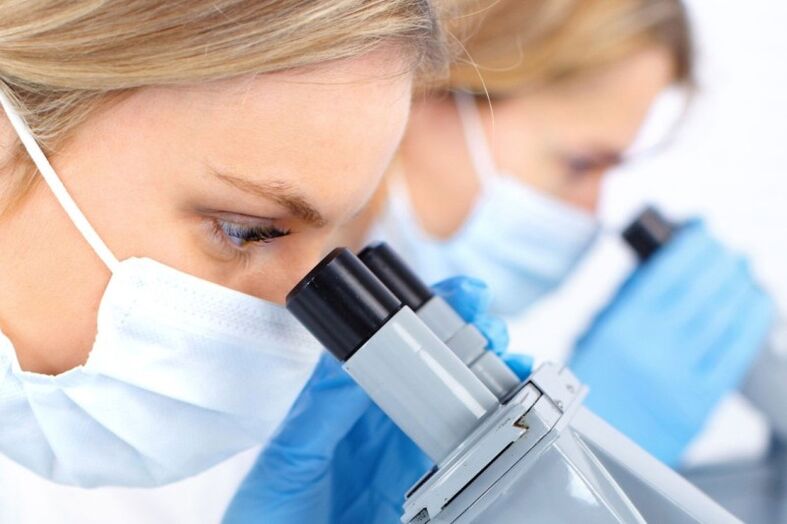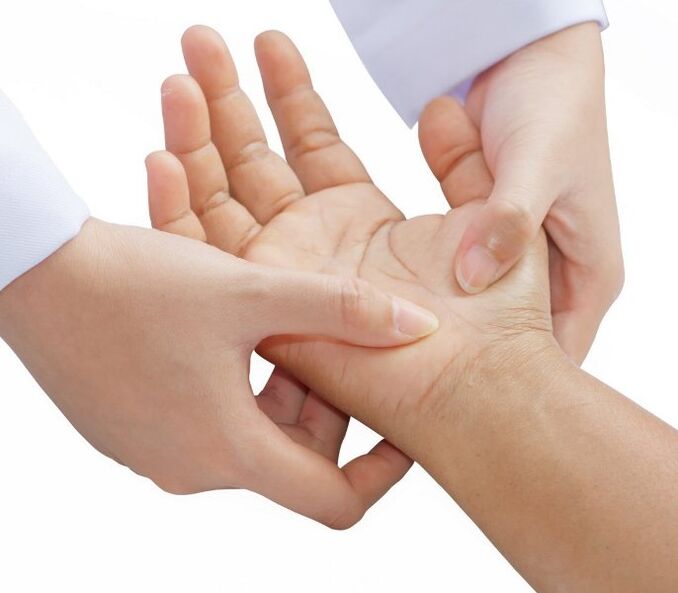Psoriasis is a common skin disease of neurological etiology. The disease is not contagious and does not spread from person to person. Often, psoriasis becomes chronic due to its latent course. Most often, the disease develops in people under the age of 30, but it can also occur in old age.
External symptoms may be absent, the clinical picture of the disease depends on its type and stage. Most often, psoriasis begins with the appearance of bright red spots, covered with dry scales, so the disease has a second name - scaly lichen.
Skin spots can vary in size, some of which may coalesce into an affected area of skin and protrude significantly from the surface.
Psoriasis causes physical and emotional discomfort to sufferers, cyclical worsening, between periods of remission and a gradual decrease in symptoms.
The patches of skin are called psoriatic plaques or papules, and they usually affect the elbows and knees, and spread to the head and lower back. The plaque can affect other parts of the body, depending on the type of disease. Treatment can last more than a year.
Cause of disease onset

Psoriasis has a number of causes related to different factors, both external and internal:
- Common causes are genetics;
- the disease can develop due to constant stress, anxiety, shock, depression and psychosis;
- various autoimmune diseases and the breakdown of the immune system create ideal conditions on the surface of the skin for the onset of the disease;
- Chronic psoriasis can also cause metabolic disturbances, as well as dysfunction of the endocrine system.
The type of psoriasis and its course depend on the etiology of the disease.
Classification of psoriasis

The disease has many different forms, the appearance and symptoms depend on:
- The most common form of the disease is droplet psoriasis. The surface of the skin has red or pink patches covered with scales. They are the exact opposite of healthy skin, which is denser and more prominent than the surface underneath. The scab is easily removed and, if disturbed, begins to bleed, causing severe itching and burning. As the disease gets worse, the nodules can grow and join together to form large areas of damage.
- Intestinal psoriasis looks different, the nodules can be pink or purple, during an exacerbation they become brighter. The scales may be larger and look like water droplets; They can also merge into large areas.
- Another form of psoriasis affects only the places where there are folds and folds of skin - the elbows, armpits, the area under the fat folds of the abdomen or chest, in the groin. The acne spots are smooth, even, not itchy and without scales. If there is friction with the clothing in the affected areas, the surface of the stain is very susceptible to injury.
- Chronic forms of nail psoriasis are also common, mainly nail plaques on the affected finger or toe. Nails lose shape, deform and discolor. Nails begin to thicken and scab, which can cause nail loss. In the early stages, nail psoriasis is easy to confuse with a fungal infection, so you need to see a doctor for proper diagnosis and treatment.
- The most severe form of the disease is pustular, characterized by the appearance of pale fluid-filled blisters that can easily rupture when clothing is rubbed. When the pustules are destroyed, pus forms and a secondary infection on the skin. This form of psoriasis is dangerous because it can cover almost the entire body, exacerbating the course of the disease.
- Rheumatoid psoriasis affects not only the surface of the skin, but also the joints and soft tissue around them. This mainly involves the knee, shoulder and hip joints. The damage is not only manifested by external symptoms, but also manifested by pain inside the joint, making the patient more painful. If the hand or foot is affected, the fingers become swollen, their sensitivity decreases and the deformity begins. In the most severe and neglected form, the patient can lose the sensitivity of the limbs and become disabled.
All of these forms may develop singly or they may occur together, it all depends on the severity of the disease.
Stages of Psoriasis

The chronic form of the disease has different stages, each with its own symptoms and characteristics:
- with an advanced stage, spots, scaly, rapidly appear and increase in size. They are usually red, but can vary in shade depending on the form of the disease. The skin in these places is very itchy, burning and painful;
- in the stable stage, the disease does not cause pain, flows in patches, the scabs grow larger and larger, which can periodically coalesce;
- With the regressive stage, papules can resolve on their own, they are nothing to worry about other than external signs.
Psoriasis is a chronic disease that alternates between exacerbations and remissions.
The reason for the exacerbation

Exacerbations of the disease can have many causes, both extrinsic and internal:
- prolonged exposure to cold causes frostbite;
- violation of the hormonal background of the body during puberty, pregnancy or menopause;
- long-term treatment with certain drugs (antibiotics), self-medication, violation of dosage when taking multivitamins and herbal supplements;
- the disease can be aggravated by climate change or exposure to the sun;
- alcohol abuse can not only provoke an exacerbation of the disease, but also complicate the course of the disease;
- trauma, burns, frostbite and other mechanical damage to the skin always cause exacerbations of psoriasis;
- Viral and bacterial infections can cause outbreaks of disease, sometimes common respiratory illnesses cause exacerbations of skin diseases.
Rheumatic form of psoriasis with seasonal exacerbations:
- in the summer - in the case of being in the sun;
- in winter - due to hypothermia.
Ultraviolet rays help papules heal, but the sun's infrared rays cause skin irritation.
Psoriasis is diagnosed without much difficulty, the disease has vivid symptoms, additional studies in the form of blood tests and skin biopsies are performed to rule out other diseases.
Treatment

Today's medicine has made great strides in the treatment of skin diseases, including psoriasis, there are several methods that can be used to treat an advanced form of the disease. Doctors determine treatments on a completely individual basis, based on form, stage, cause, and symptoms. The treatment is always carried out in a comprehensive way, combining drug treatment and physical therapy.
Drug therapy includes the use of both internal and external drugs:
- to eliminate skin pathologies, ointments based on salicylic acid, sulfur, dithranol and urea are used;
- glucocorticoid ointment;
- lotion to treat the scalp.
In the period of exacerbation, hormonal ointments are used to eliminate the inflammatory process, treatment is always started with less powerful ones. If the disease starts to progress again, use strong fluoride agents. They are used for two weeks to achieve results.
For the elderly and children, ointments with the fewest side effects are used.
With an increase in dosage, ointments based on dithranol are prescribed to eliminate the inflammatory process, itching and swelling.
Prepare withalcipotriolhave a direct curative effect on the factors that promote disease pathogenesis. It has anti-inflammatory and immunomodulatory effects. Usually, a two-month course of treatment has noticeable positive results, the skin rashes can disappear completely. This remedy has no side effects on the form of skin atrophy and gives a lasting effect. Medicines are used to treat teardrop psoriasis, which is difficult to treat.
All medications must be alternated, otherwise addiction can occur and the body will stop responding to them.
Treatment with aromatic retinoids is also considered effective.
In addition to drug treatment, several requirements must be met for successful treatment:
- follow a diet;
- take the necessary vitamins under the supervision of a doctor;
- avoiding stressful situations, falling into a state of depression, having to consult a doctor to be prescribed the necessary items;
- protect the affected areas from chemical exposure as much as possible, especially the hands and nails;
- wear only cotton clothing so as not to cause further skin irritation;
- Do not consume alcoholic beverages and confectionery, and also avoid exposure to allergens.
If all the recommendations and rules of treatment are followed, it is possible to achieve remission of the disease, and in some cases - complete cure.























